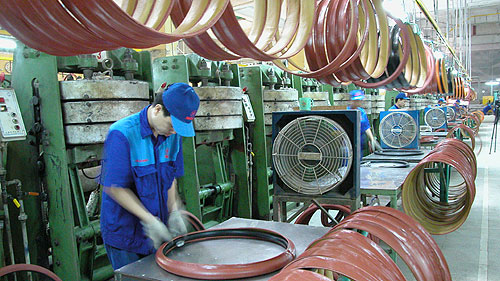Five key solutions for industrial development
Vietnam has industrial development policies, many of which have proved ineffective as trade performance still depends a lot on imports and domestic technologies are limited.
The Vietnam Industrial Competitiveness Report 2011 (VICR 2011) refers to the two elements in connection with industrial competitiveness - namely the role of trade liberalization in economic restructuring and production, and the need for industrial policies and strategies which take into account national priorities as well as global advantages and disadvantages.
From 2005-2009, Vietnam has made great strides in improving its industrial competitiveness, jumping 14 notches in four years to overtake big rivals such as Egypt, Morocco and Russia.

VICR 2011 says the nation’s export growth in manufactured products was strong enough to overshadow China’s in the 2000-2009 period.
Manufacturing value added (MVA) growth increased from US$5.8 billion in 2000 to US$15.4 billion in 2009 thanks to the strong links between industrialization and economic development.
Key solutions
According to VICR 2011, industrial competitiveness shows the capacity of nations through strong industrial presence in both domestic and international markets and development of industrial structures based on higher technological added value.
Industrial development in each nation depends on the business environment, labour efficiency, technology, finance, input, infrastructure and the quality of training support and technological services.
UNIDO points that despite achieving remarkable progress in industrial development, Vietnam’s industrial competitiveness index is still lower than other countries (15 notches lower than Indonesia and 25 notches lower than the Philippines).
Since 1995, Vietnam has devised 80 development strategies and plans for independent industrial sectors. However, the country has failed to come up with a master plan to carry out these strategies effectively.
UNIDO Managing Director Wilfried Luetkenhorst says industrial competitiveness does not depend totally on a nation’s reserve of natural resources and low- tech manufacturing areas. So, Vietnam needs to develop products from renewable natural resources and consider industry a core factor in its economic growth.
Judging from Vietnam’s industrial environment, VICR 2011 proposes five key solutions to the country’s industrial development in the future.
First, remaking industrial policies and strategies: There should be an industrial code serving as a legal foundation for issuing legal documents on industrial development. It is essential to adopt specific policies for small and medium-sized and State-owned enterprises.
Second, diversifying industrial sectors with products of high added value: Priority should be given to developing potential areas in order to create more jobs and upgrade technological standards.
Third, developing human resources for the manufacturing industry: It is essential to build an education and training system in charge of improving professional skills and quality of the workforce.
Fourth, developing technologies: It is imperative to limit import surplus of high-tech products. The Government and private sectors need to coordinate in renovating national technologies.
Fifth, attracting foreign direct investment (FDI) for production: FDI structure should be focused on the balance of trade to lessen dependence on imports.
(VOV)

